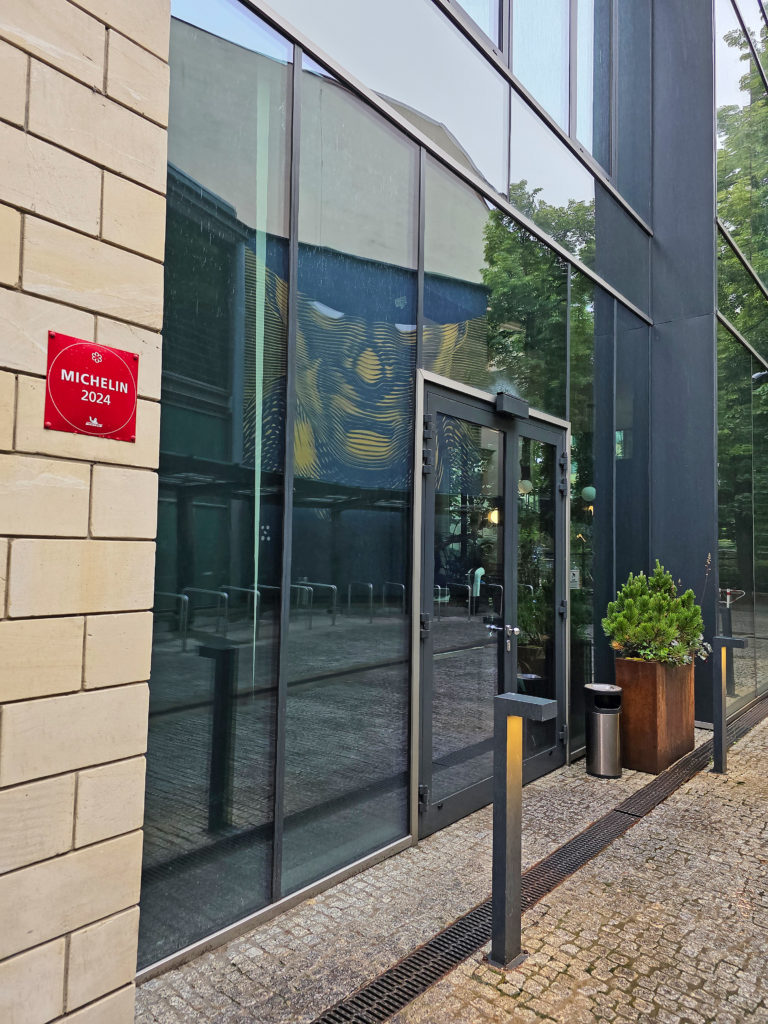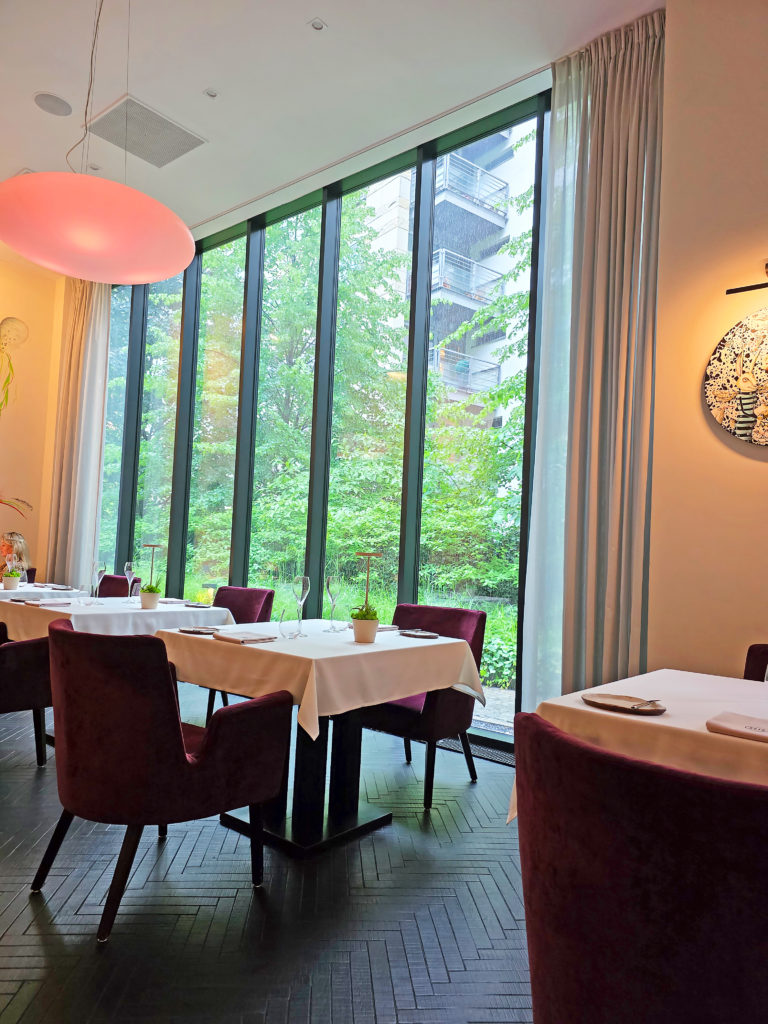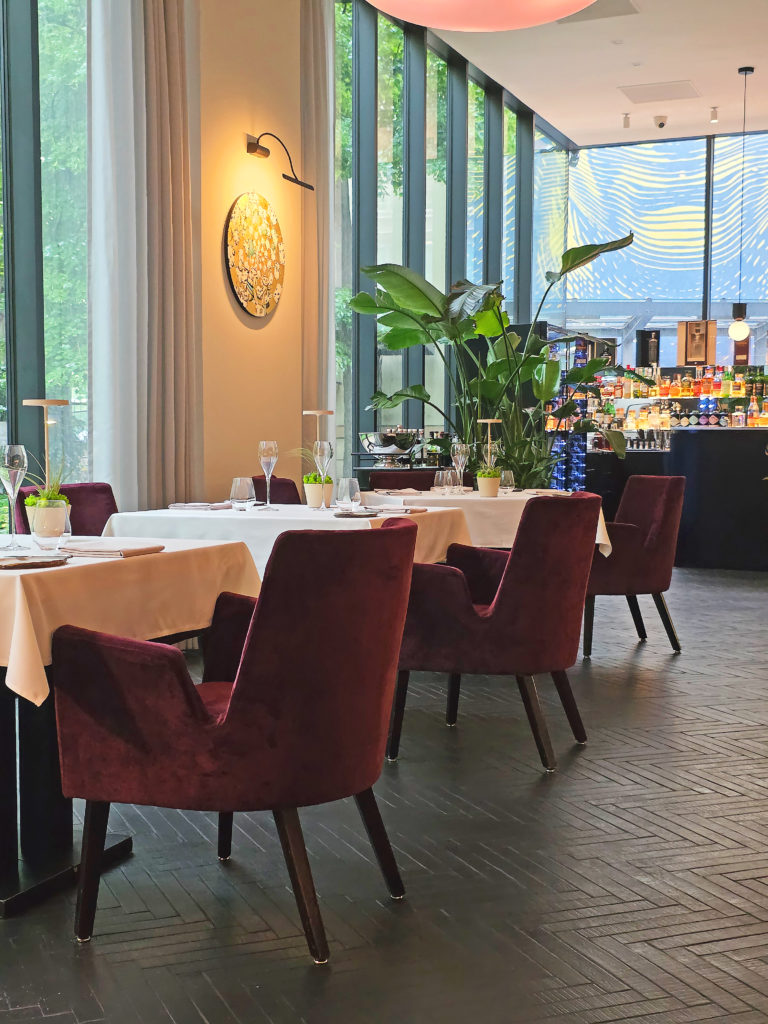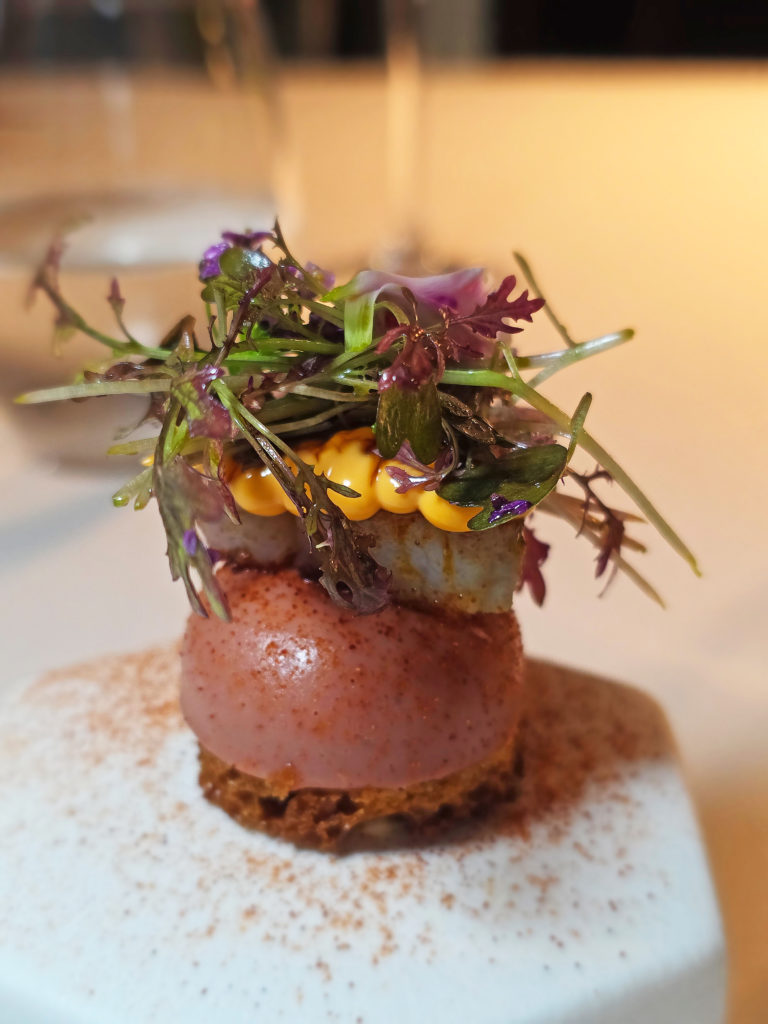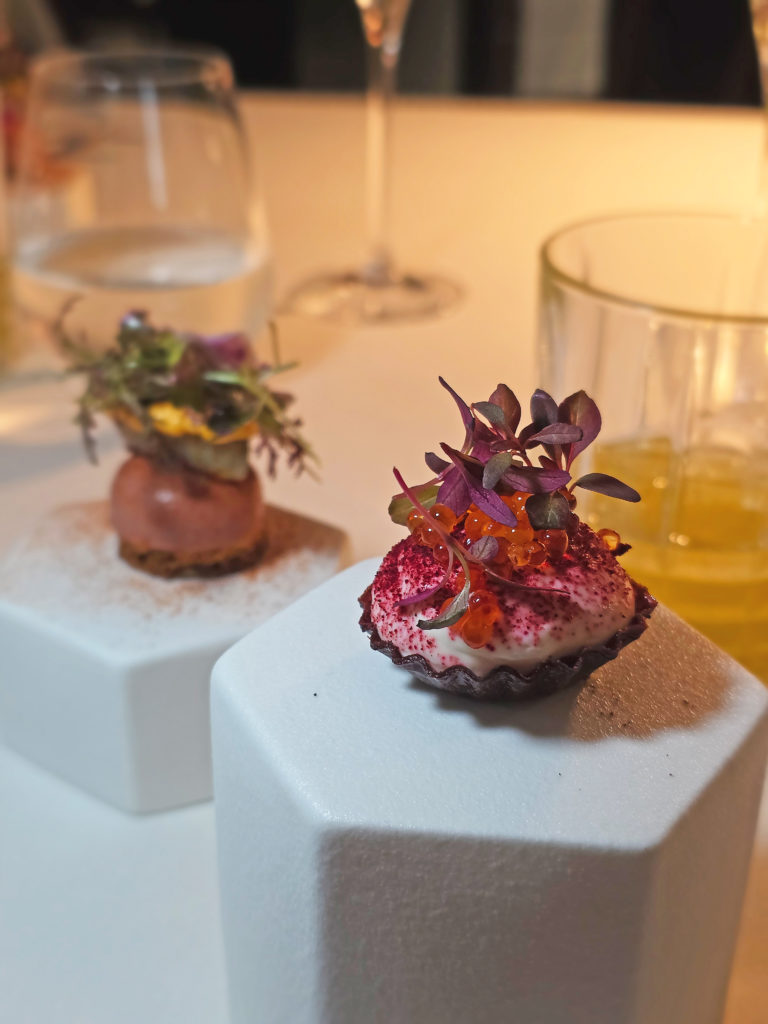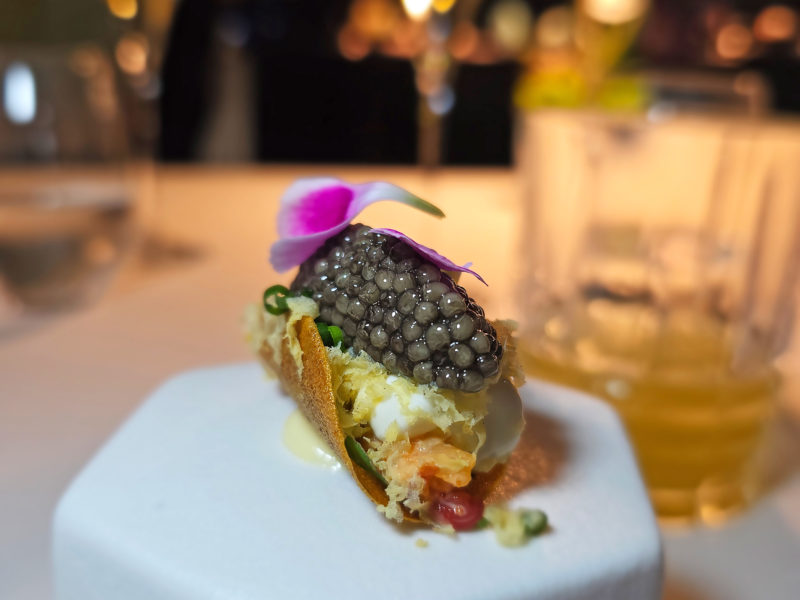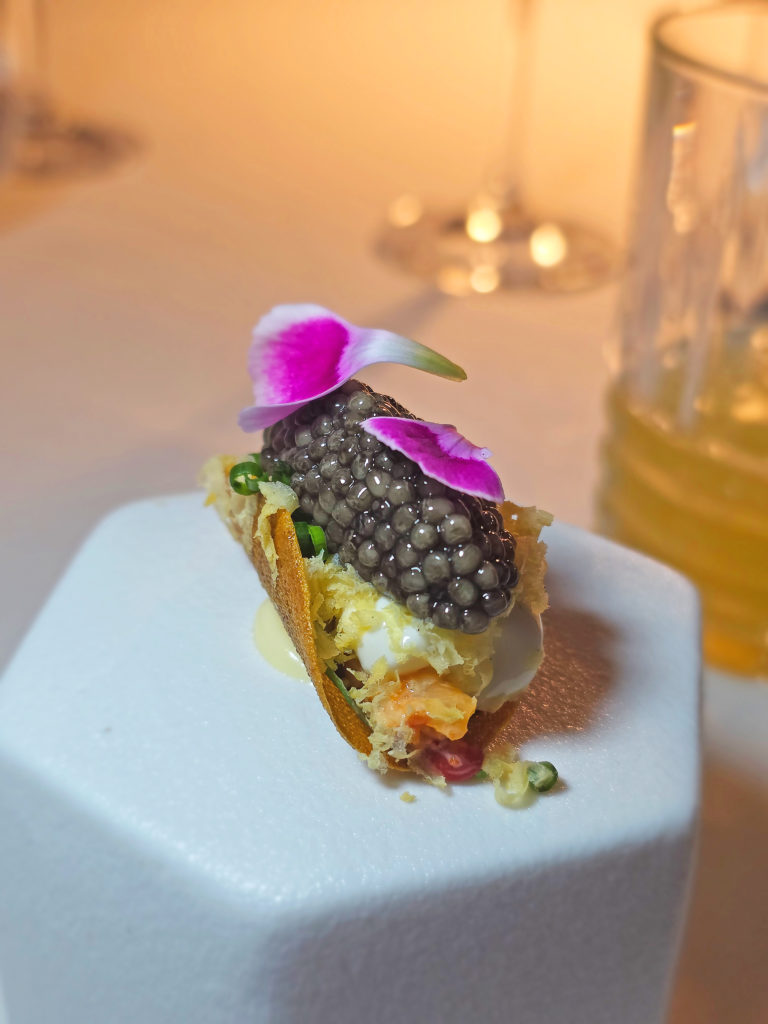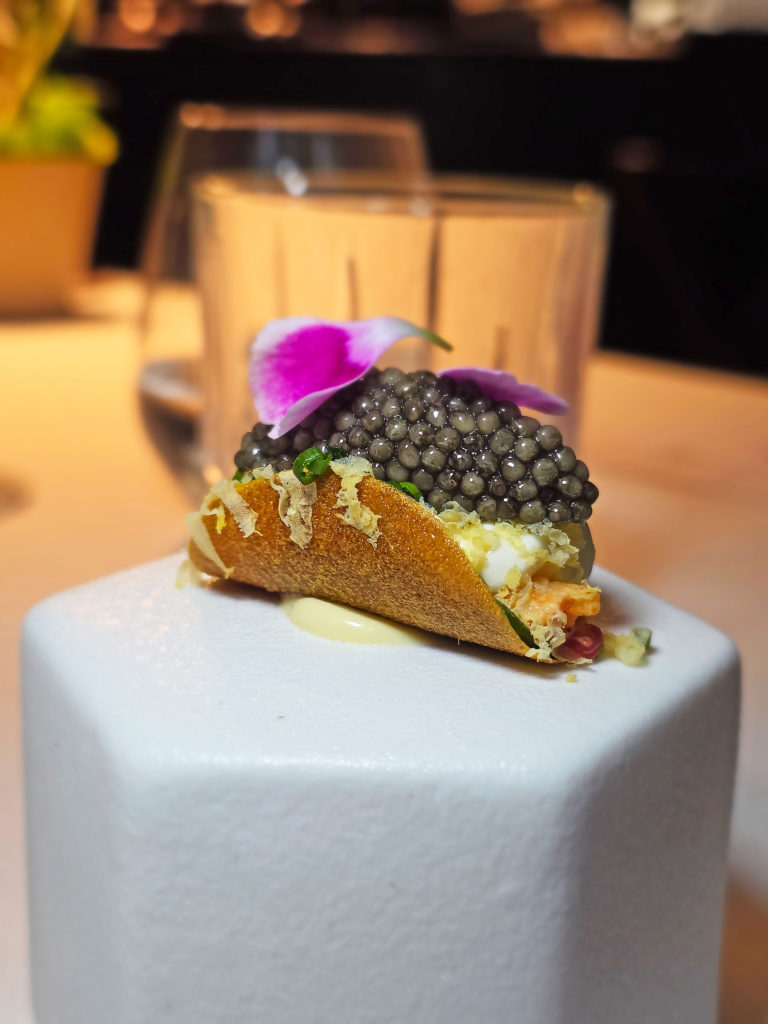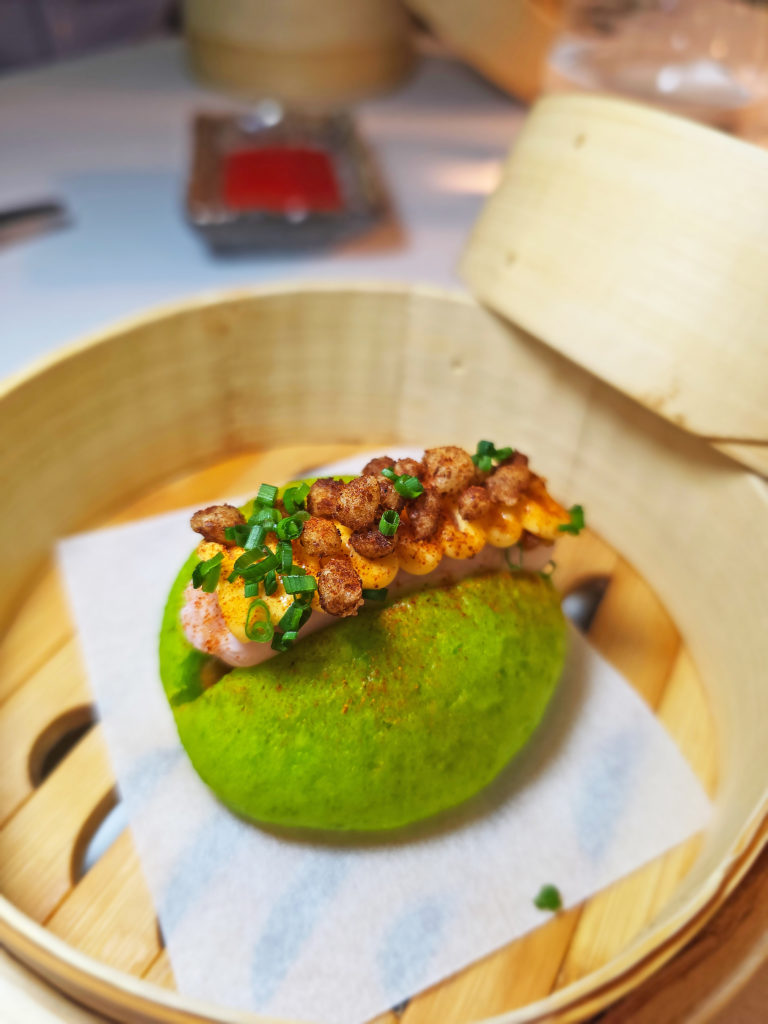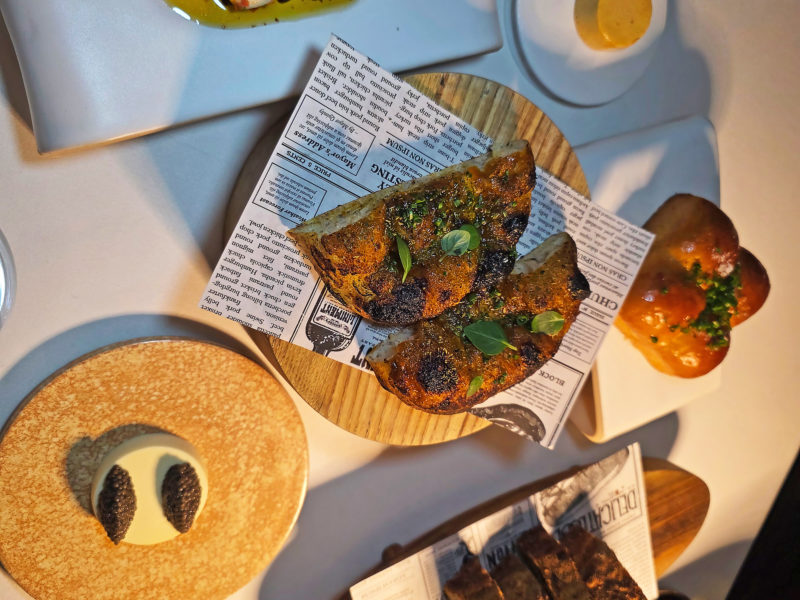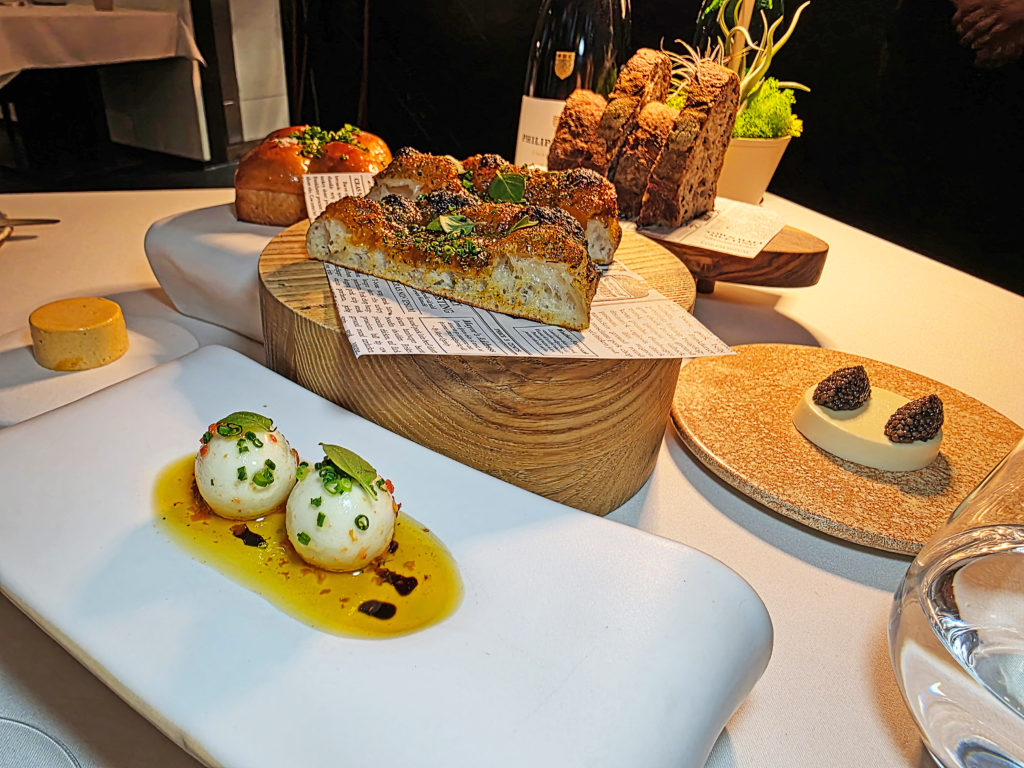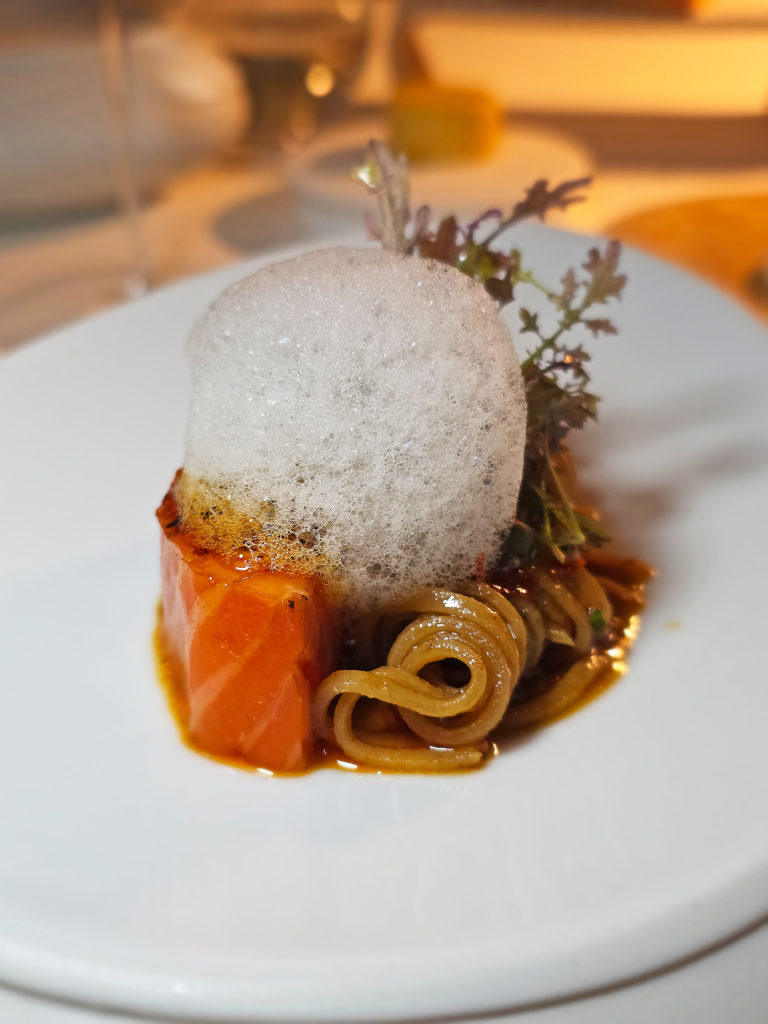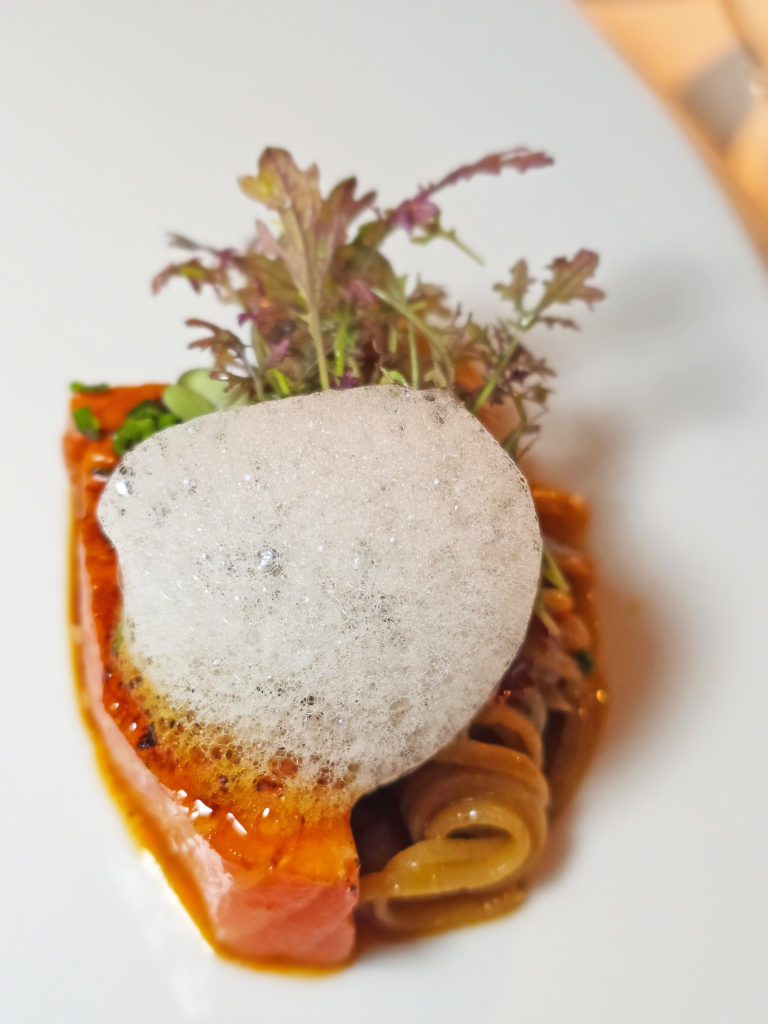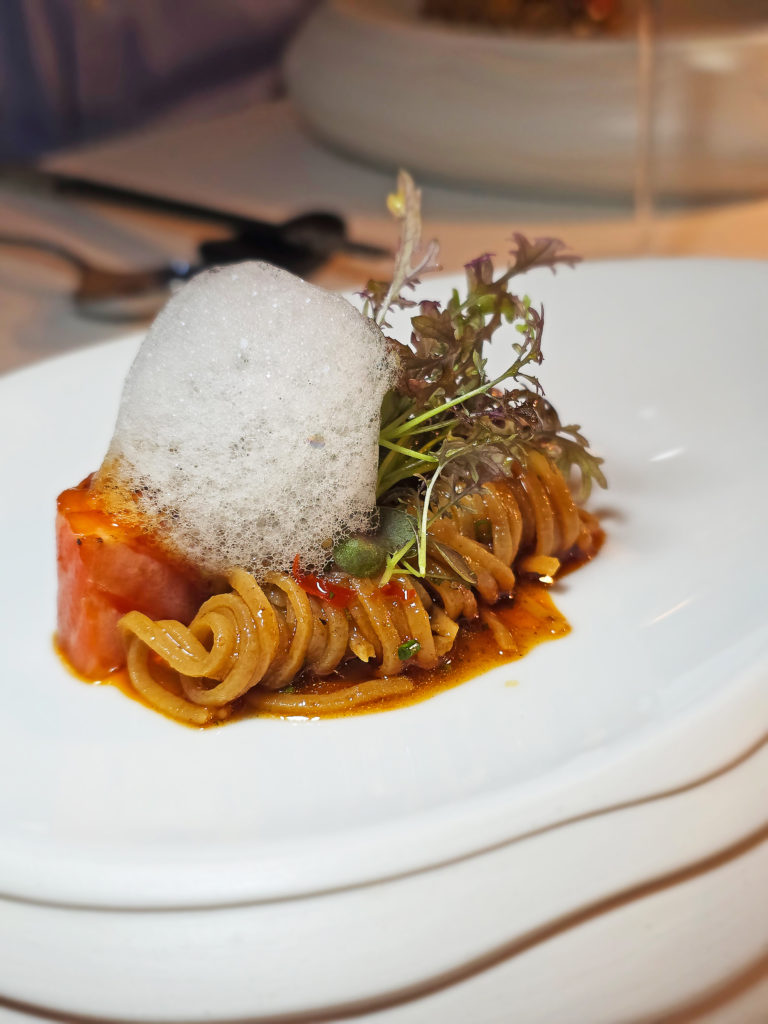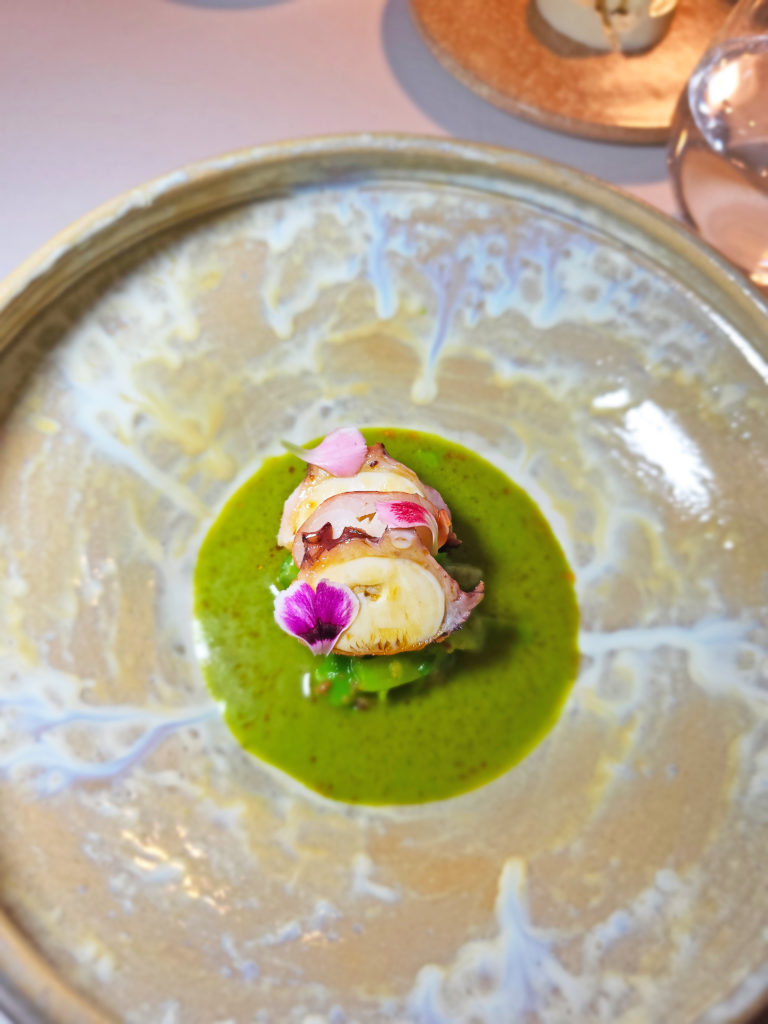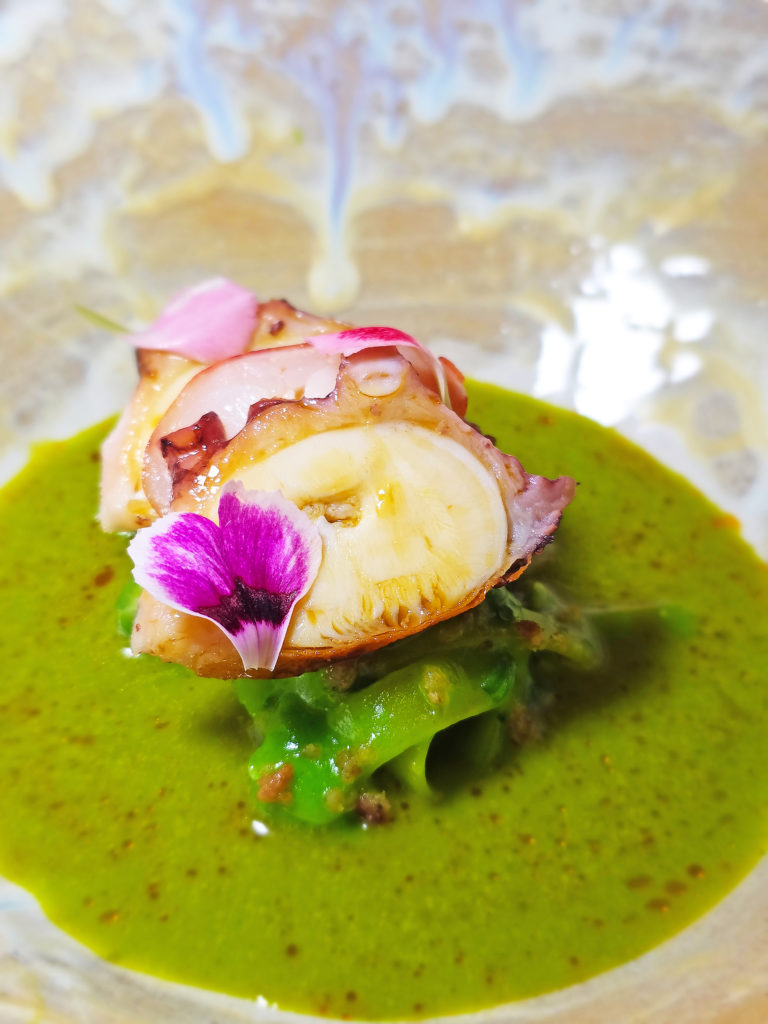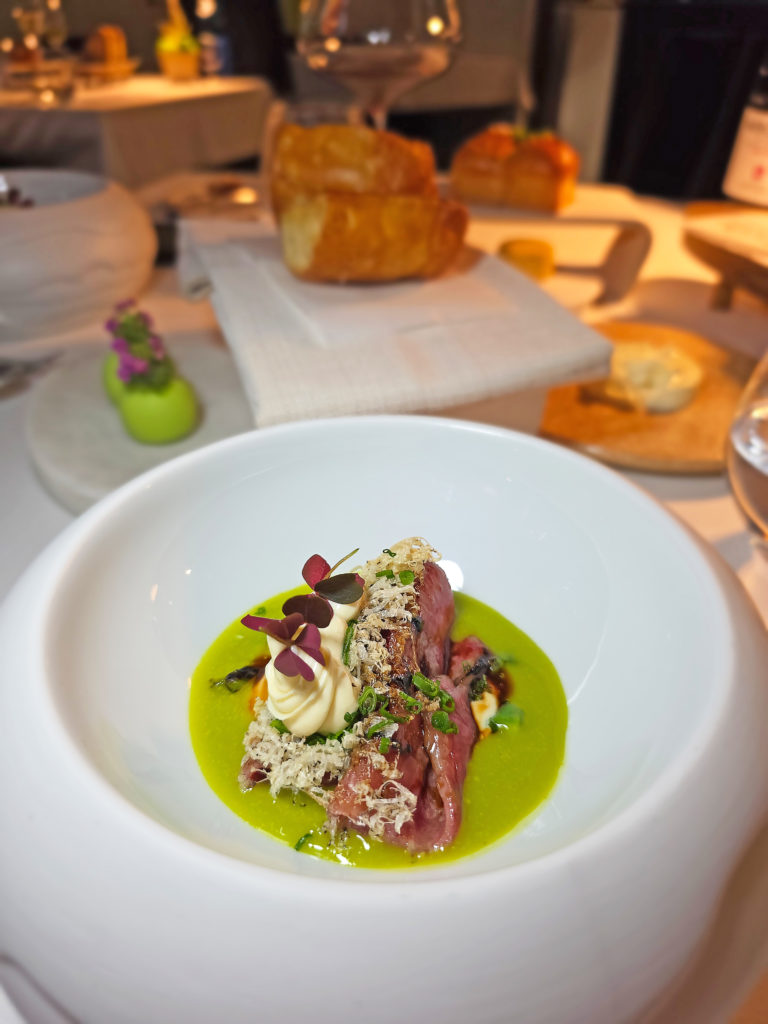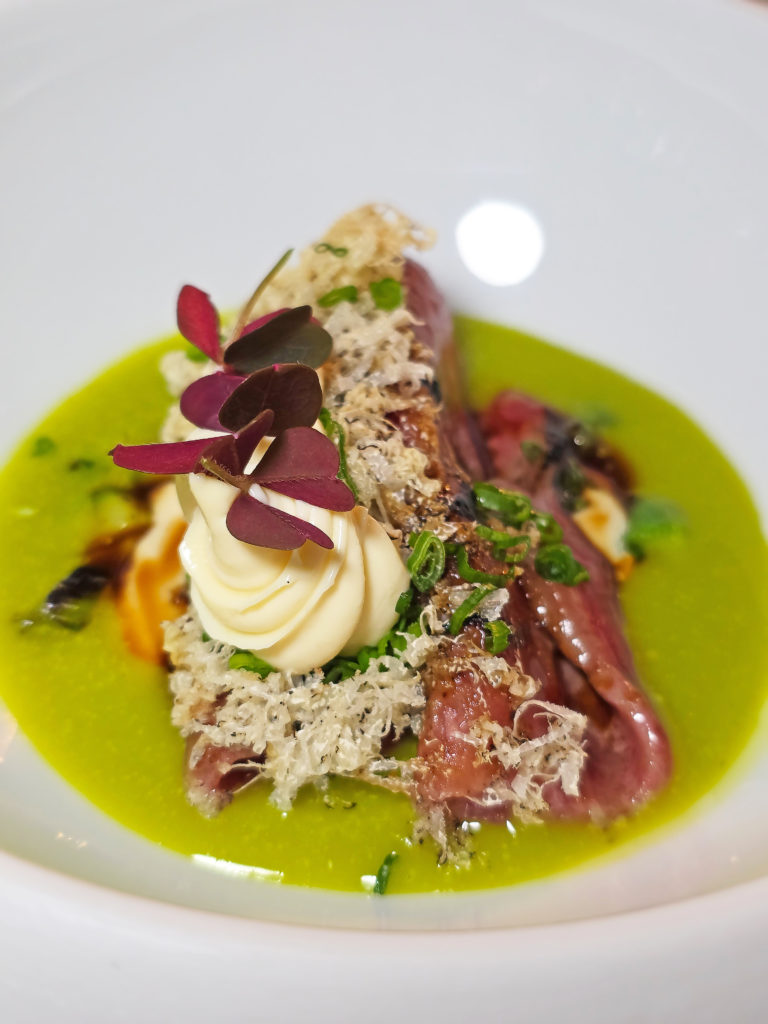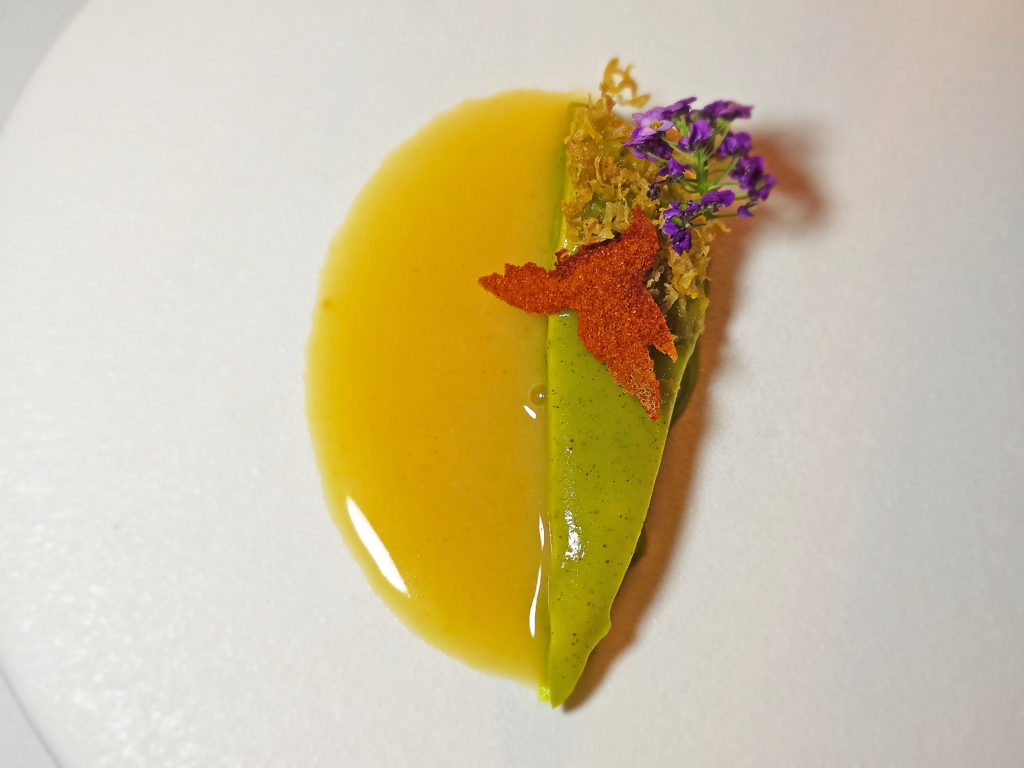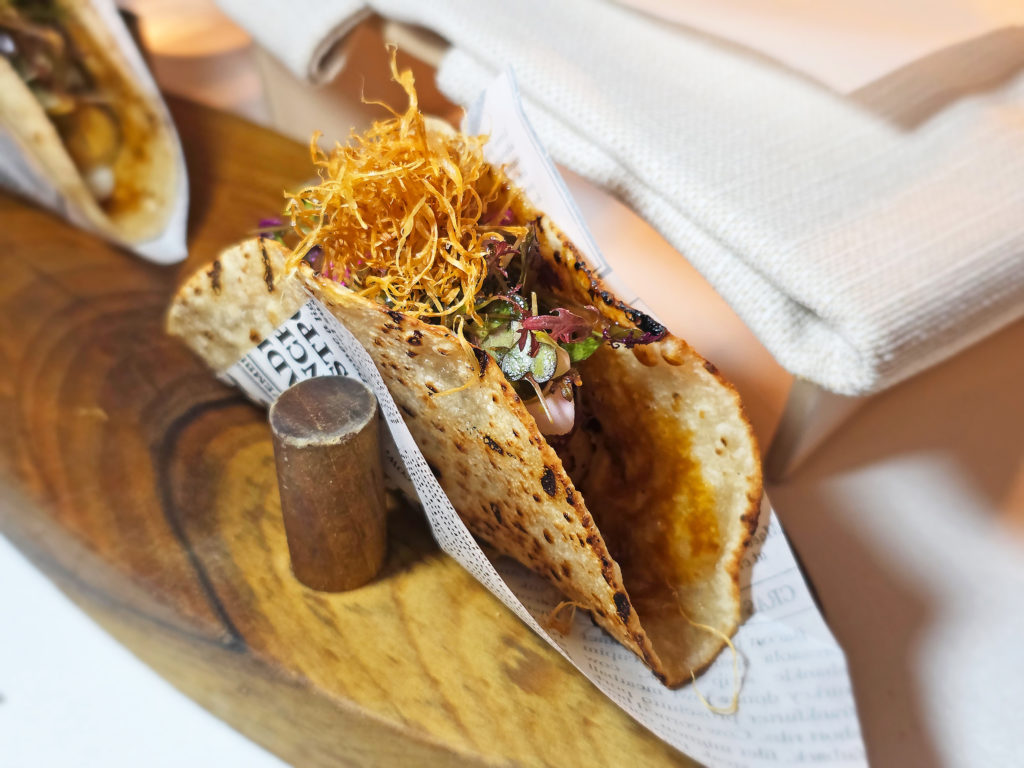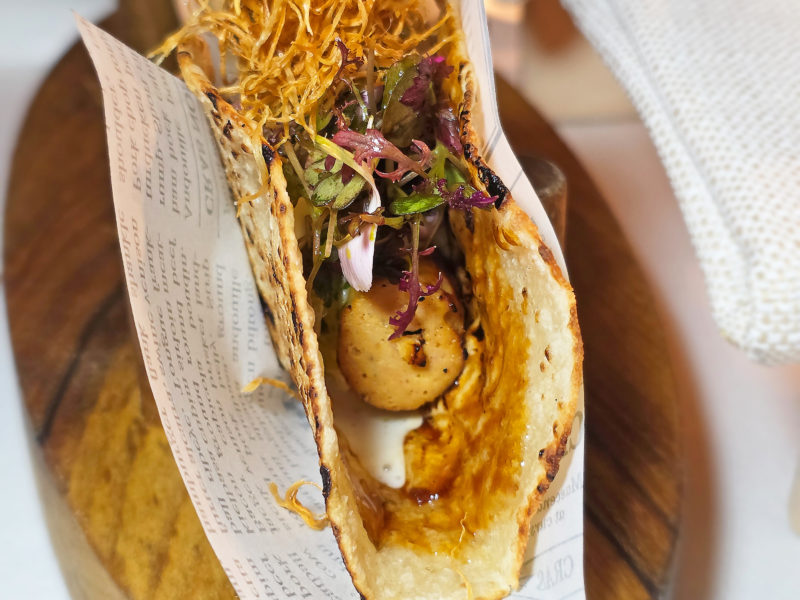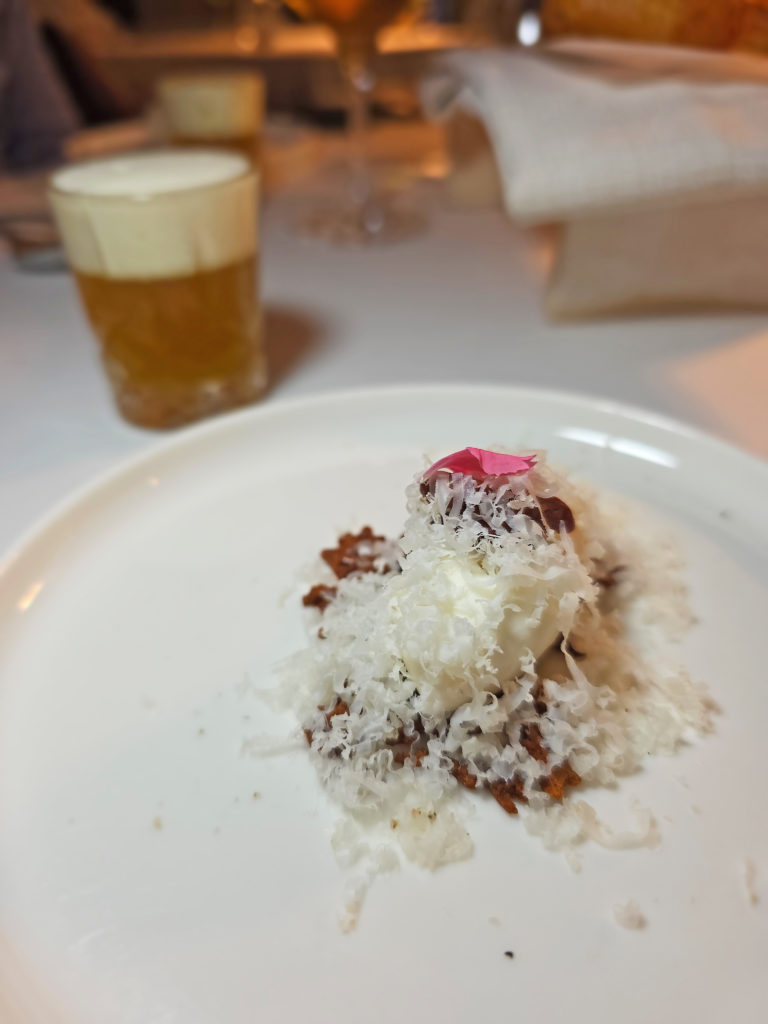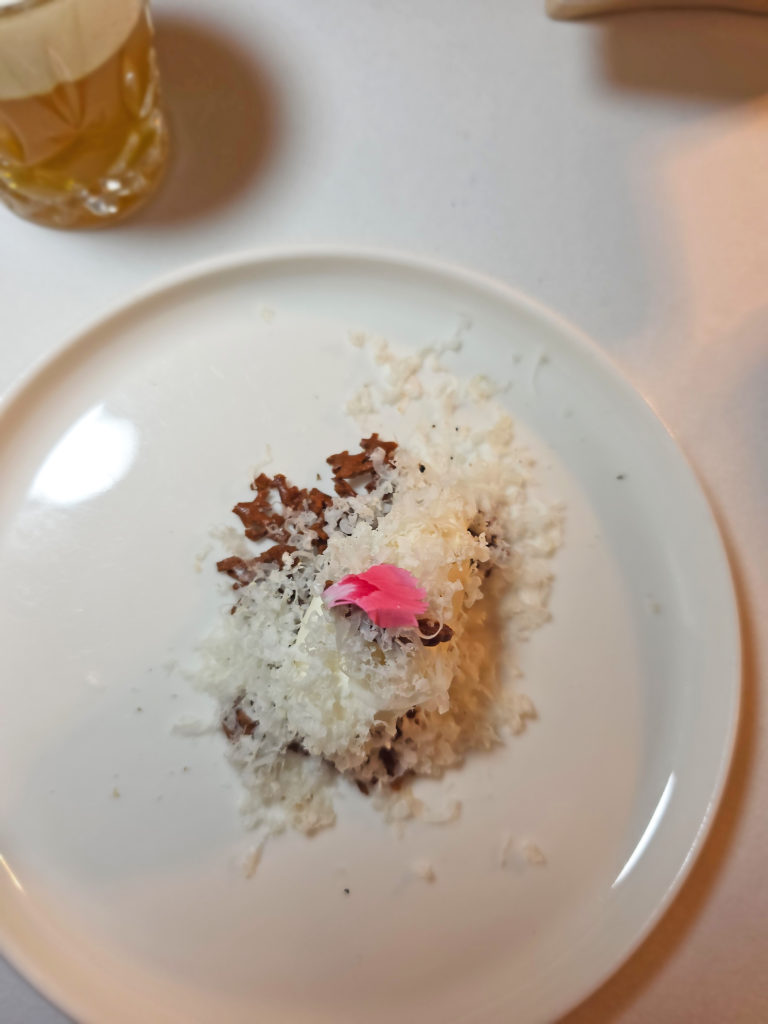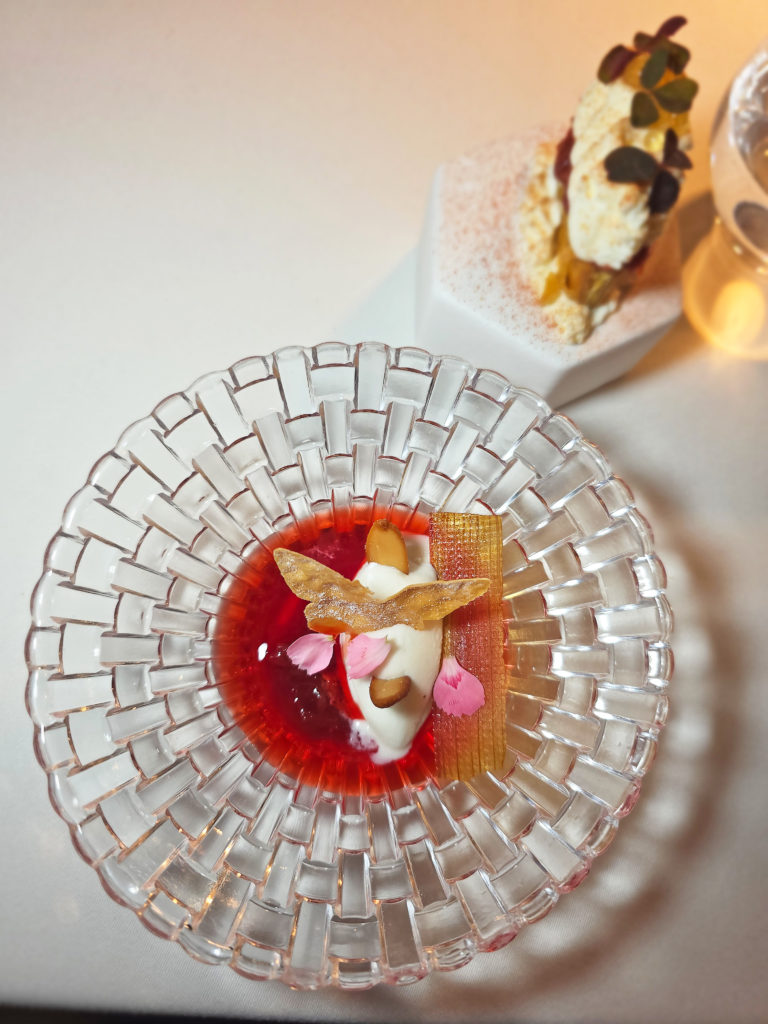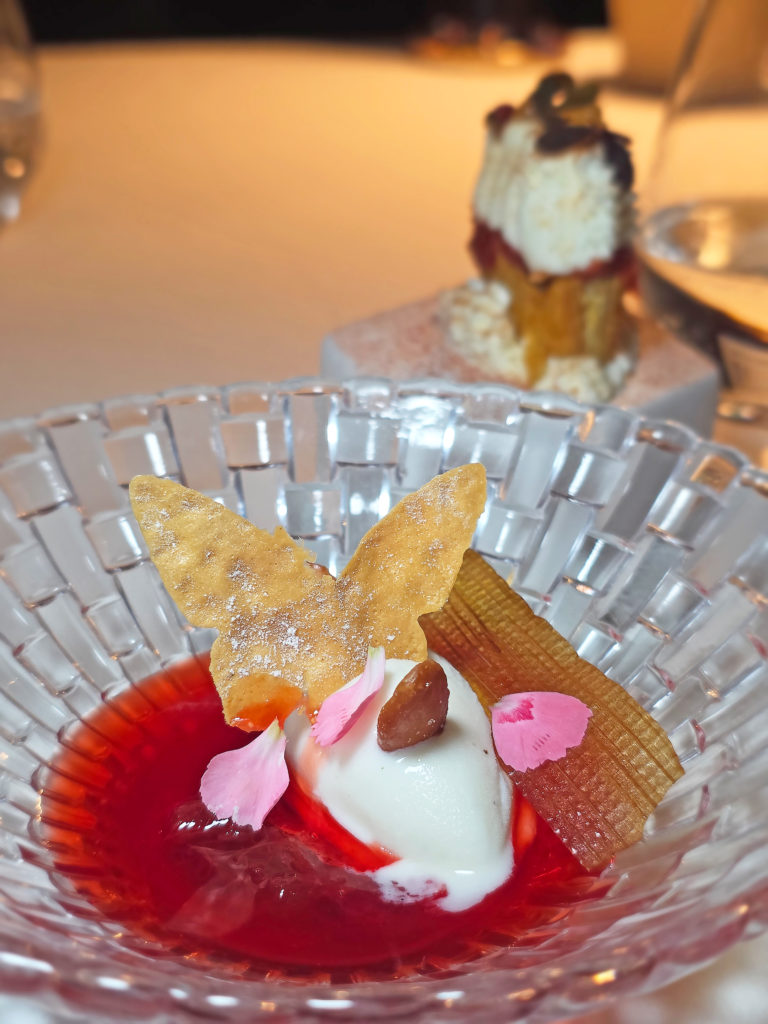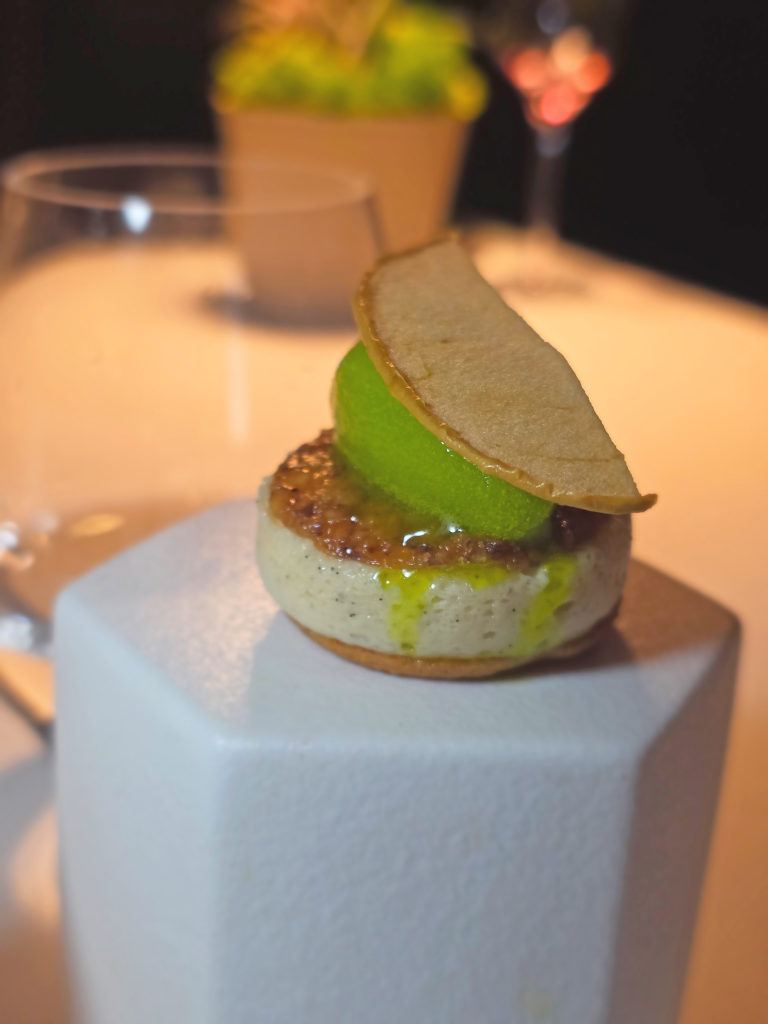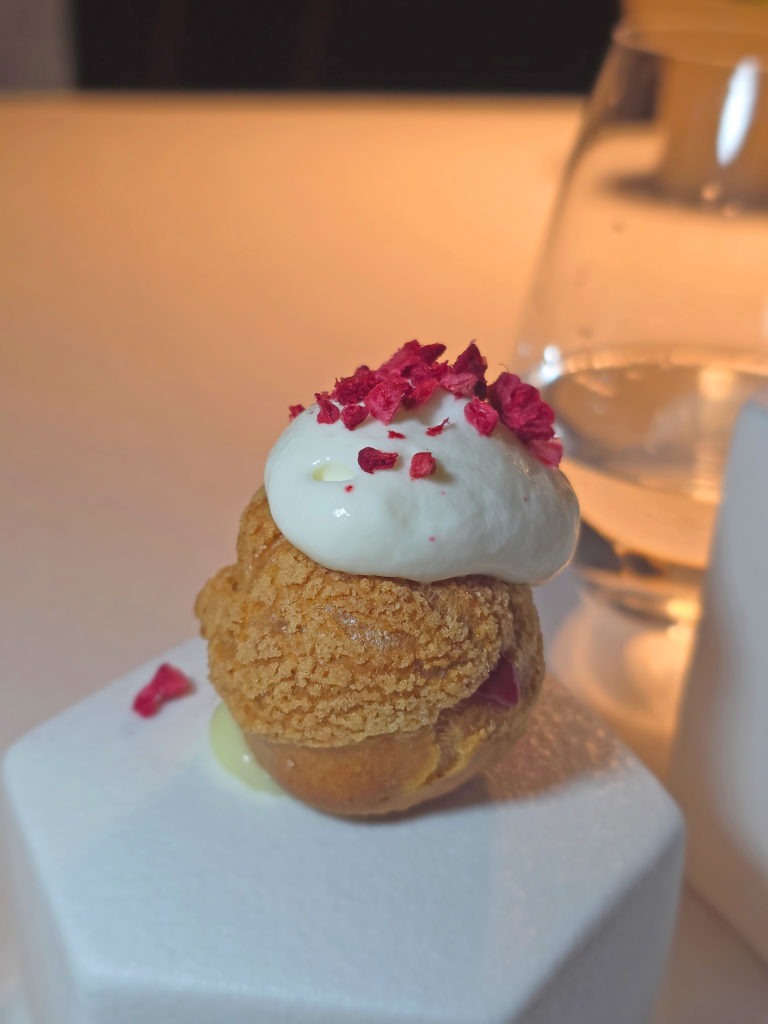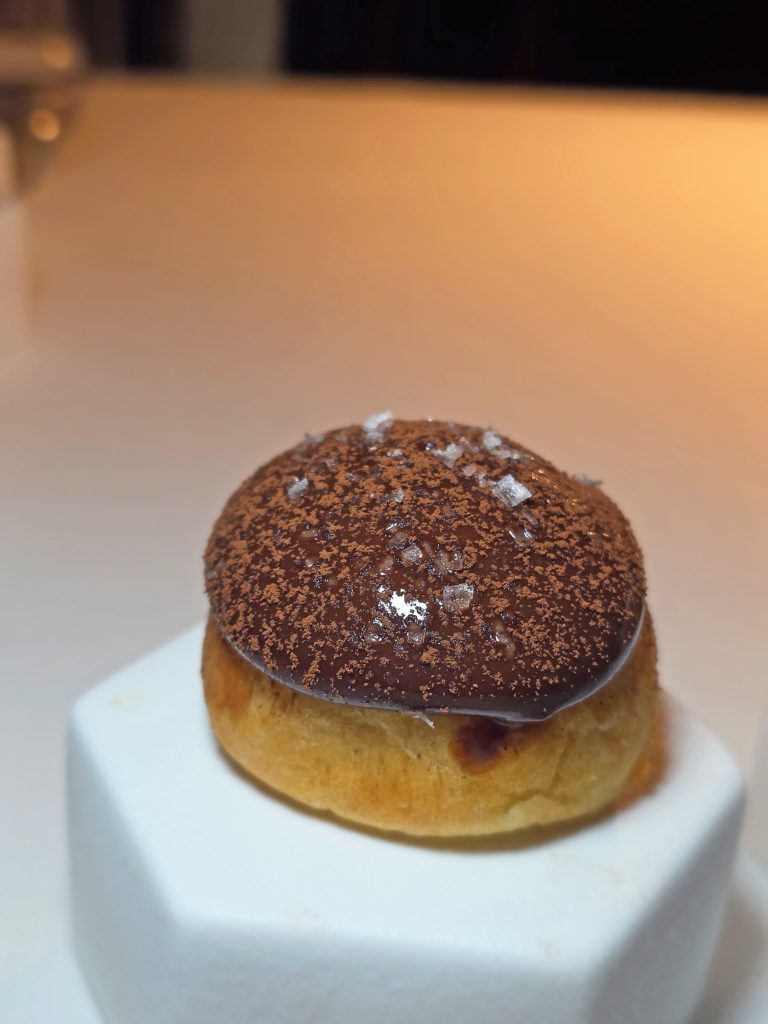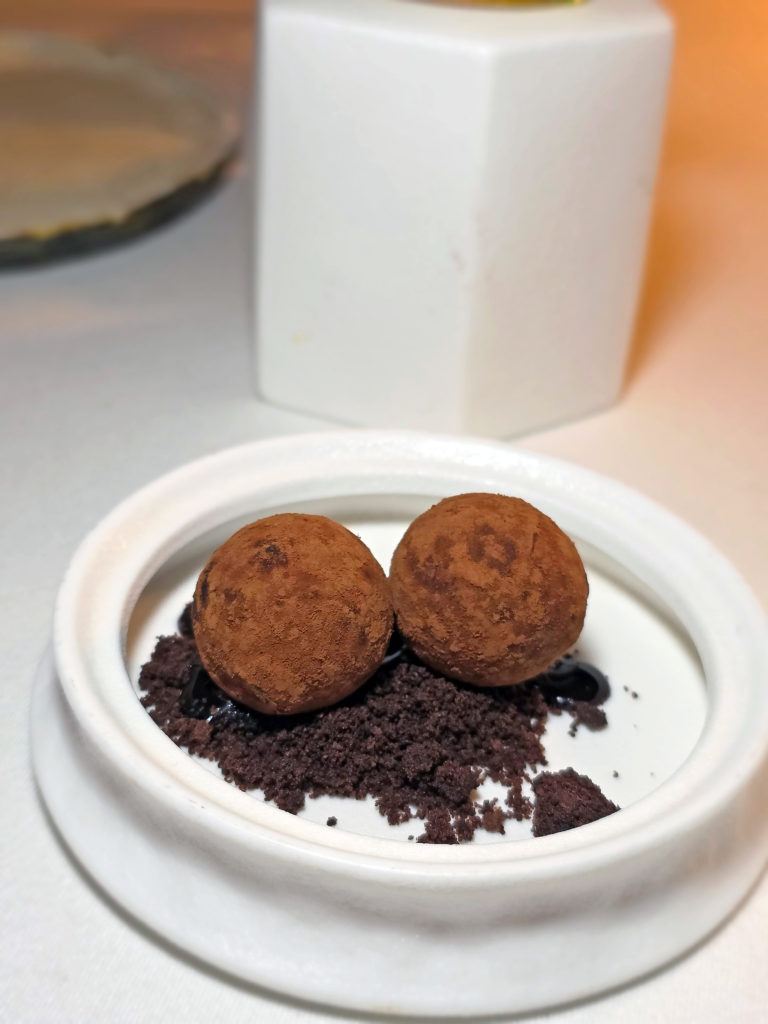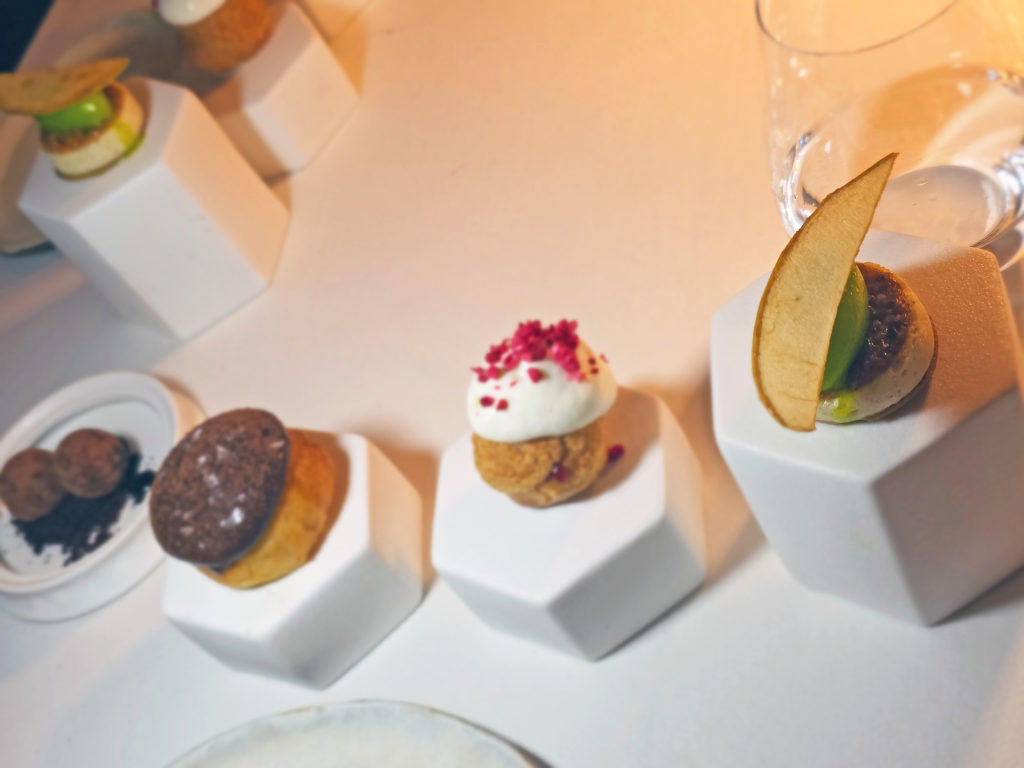Nuta is a refined restaurant in Warsaw offering tasting dinners. Notably, just thirteen months after opening, it earned its first Michelin star (June 2023) – and retained the distinction a year later. The restaurant is run by Italian chef Andrea Camastra – born in Bari and raised in Monopoli (Apulia). He has lived in Poland for over a decade and is among the most decorated chefs in the country. The Gault&Millau guide awarded him the titles of “Chef of the Future” (2015) and “Chef of the Year” (2017), and in 2019 he was included in the global Le Chef “Top 100 Chefs” ranking. In 2024, he also made the Excellence Awards list of The Best Chef competition. Chef Camastra combines his Italian roots with seasonal Polish produce and subtle Asian accents. A hallmark of his style is molecular gastronomy, which he develops in his own laboratory – enabling the dishes to stand out with precisely balanced flavour notes. Guests can choose between the shorter Virtuoso menu and the more extensive Maestro, both rooted in the same philosophy of clean, expressive tastes. We opted for the Maestro menu along with the accompanying classic wine pairing.
The interior of the restaurant is spacious. Large windows let in plenty of light, although on the day of our visit it was raining – so the space was a touch darker. The windows overlook a quiet courtyard, which – given the central location near Plac Trzech Krzyży – allows for a rare sense of calm and warmth. The atmosphere is further enhanced by discreet lighting. At tables covered with white tablecloths stand comfortable armchairs, inviting guests to relax and spend several hours enjoying their dinner. The open kitchen forms the restaurant’s focal point – like a theatre stage, it draws the eye, as most of the tables are arranged to face it. The precision of the whole team is truly impressive, and in Chef Andrea Camastra’s work on the dishes, one can see both passion and dedication. This has been the case during each of our visits.
We began our dinner with a brilliant selection of amuse-bouches. First came a beetroot tartlet filled with aromatic ćwikła (grated cooked beetroot) and a velvety goat’s cheese mousse. What impressed us most was the tartlet base – exceptionally thin, almost paper-like, yet strong enough to hold the filling perfectly in place. On top glistened trout roe, finished with a delicate amaranth leaf. One could say this was a classic flavour combination – but presented here at its very best. The bold saltiness of the cheese, the gentle sweetness of the beetroot, and the springy pearls of roe formed a harmonious, multi-layered composition.
The second bite was a reinterpretation of Kashubian herring, a traditional snack from northern Poland – here playfully transformed into Kashubian-style mackerel. A piece of mackerel was served with vegetables prepared in the Kashubian style, a silky duck liver parfait, and a touch of mayonnaise. It all rested on a thin, crispy toast and was topped with a micro salad. The fish delighted with its creamy texture and deep, salty notes reminiscent of herring, but in a more concentrated, aromatic form. The variety of textures complemented the flavour profile, capturing the essence of a traditional dish in a refined and precise execution.
To refresh the palate, we were served one of Nuta’s signature cocktails – a vodka-based drink infused with pink pepper, with fresh and pickled cucumber juice, and passion fruit. It added a light, spicy-fruity accent before the next courses.
The next small dish was also a nod to Polish culinary heritage. In many Polish households, a quick everyday lunch might consist of potatoes – fried or boiled – served with a fried egg and buttermilk, kefir, or soured milk. Inspired by this humble meal, the chef presented a crisp fried potato slice shaped like a taco, filled with thick sour cream, grated dried egg yolk, and five-star Antonius caviar, sprinkled with finely chopped chives. The creamy sour cream enveloped the crisp potato, while the yolk and caviar brought a well-balanced saltiness and pronounced umami. Altogether, it tasted like refined comfort food in a bite-sized format – simple ingredients reimagined in a wonderfully modern form.
Next came a particularly playful interpretation of ryba po grecku (fish Greek-style, although it has nothing to do with Greece) – a traditional Polish dish typically made with cod, served with a sauce of root vegetables and tomatoes, often eaten on Christmas Eve. At Nuta, it appeared in the form of a hot dog. A soft, steamed bun – green thanks to the addition of wild garlic – enclosed a delicate zander sausage, nestled among the classic vegetables associated with the dish. The whole creation was topped with Greek mayonnaise spiced with ‘nduja, a sprinkling of chives, and crispy tempura pearls dusted with onion powder. On the side, there was a dipping sauce of sweet ramiro pepper ketchup. The contrast between the soft bun and the crunchy pearls, the aroma of garlic and onion, and the vibrant flavour of the vegetables made this a brilliantly balanced, multi-textured bite.
The following course was a deconstructed chłodnik z botwiny – a Polish cold beetroot soup – served in multiple layers of flavour and temperature. On the plate were intensely flavoured chłodnik ice cream, paired with caviar and herbs; at the bottom, a crisp apple chutney and horseradish gazpacho with dill oil. To accompany it, a gently smoked belly of salmon trout was served separately. Following the chef’s recommendation, we tried to gather as many elements as possible onto each spoonful to blend the flavours. The creamy saltiness of the fish and caviar met the cool freshness of horseradish and dill, the ice cream tasting like the very essence of a Polish summer soup, and the sweet-sour apple chutney added a pleasant contrast. Altogether, the elements came together in a masterful reinterpretation of a local classic – exactly the kind of creativity we most appreciate in a Michelin-starred setting. Brilliant.
The next course was a celebration of bread. A selection of baked goods was served with a chilled glass of champagne, highlighting the shared yeasty note across the table. The offering included a Neapolitan-style pizza with tomatoes and parmigiano reggiano, paired with a mozzarella parfait shaped into a ball and immersed in olive oil; a buttery, soft brioche; rustic pane di Matera-style bread; and a fragrant loaf with plum and nigella seeds. These were accompanied by Antonius caviar butter and house-made ‘nduja butter. The warm pizza impressed with the creaminess of the mozzarella and the intense aroma of tomatoes, while the contrast between the soft dough and bold toppings struck the perfect balance of simplicity and finesse. Deeply aromatic and absolutely delicious.
Next came soba noodles with a sauce made from fermented chilli and a touch of house-made ‘nduja, served with confit trout at room temperature and a Szechuan pepper foam. The fish was exceptionally delicate – almost buttery in texture – and simply melted in the mouth. The chilli and pepper sauce added a pleasant warmth and a deep, aromatic flavour that infused the entire dish. With its intense, comforting taste and flawless texture, it stood out as one of the highlights of the evening.
The following course brought together Italian, Polish, and Asian flavours. It featured tagliatelle with ingredients that combined the classics with a successful herbal twist. At the base, beneath the pasta, was green pea – particularly juicy and sweet – with pieces of pancetta. On top of the tagliatelle lay house-cured guanciale and tender octopus. The dish was enveloped in a warm, aromatic sauce inspired by Thai green curry, but made entirely with Polish herbs. Lovage, among others, was clearly present – adding a distinctive freshness without overwhelming the dish. The octopus was cooked to perfection – firm in texture yet incredibly soft. The pasta had a pronounced egg flavour and an ideal bite. Altogether, the dish was beautifully balanced – the freshness of the peas and herbs on one side, and the warming, creamy depth of the sauce on the other. It was paired with an oaked Chardonnay – a particularly well-matched choice.
The next dish was a reinterpretation of vitello tonnato using beef. The meat, served in thin, practically raw slices, was juicy, slightly fatty, and simply melted in the mouth. Underneath was a creamy tuna and anchovy sauce, with asparagus and a touch of mayonnaise. The flavours were rich in umami, and the accompaniments complemented rather than overshadowed the beef – allowing it to take centre stage. On the side, a small sphere of mizeria with a liquid centre offered a refreshing palate cleanser, while the toasted savoury panettone with onion provided a slightly sweet, contrasting note.
Next came a two-part dish – chicken and kebab – each paired with a different wine: a rosé with the chicken and a Barolo with the kebab. The corn-fed chicken breast from Podlasie was gently confited and served in a courgette and mint emulsion, with a velouté sauce based on alliums and white asparagus. The chicken had a perfect, buttery texture – soft, delicate, and wonderfully juicy.
The second element – the kebab – was served on a flatbread with a salad of pickled young cabbage with mustard seeds, shimeji mushrooms, and a flavourful sausage made from chicken leg meat, seasoned with tandoori spices. The flatbread was pliable and lightly charred. The combination of the spiced sausage and the pickled cabbage evoked familiar flavours and was a brilliantly executed nod to the hugely popular street food scene in Poland – elevated here with great finesse.
The next course was a cheese plate – but in an unexpected and imaginative form. In fact, it has been one of our favourite dishes on the menu since our very first visit to Nuta. A pear consommé with warm gorgonzola foam brought together the intense sweetness of fruit with the bold, salty depth of cheese. The contrast in temperature added expressive depth. Accompanying this were a walnut crumble with ice cream scented with delicate honey notes and topped with grated pecorino. A sweet Tokaji completed the course, perfectly enhancing the notes of honey, fruit, and nuts. Every element worked in harmony – it was comforting, crisp, and exquisitely balanced. A cheese course one wants to return to again and again.
Then came the dessert – a seasonal creation with a delightful interplay of textures. On the plate were delicate almond ice cream with a distinct yet subtle aroma, toasted almonds, and rhubarb sauce featuring various textures of the fruit – including a thin, crisp chip. Alongside sat a mille-feuille filled with luscious whipped cream, adding crunch, creaminess, and a gentle sweetness. The dish was finished with small honey caviar pearls and wood sorrel, which brought a light, refreshing acidity. The sweet-sour rhubarb, almonds, and crisp elements complemented each other beautifully, and the pairing with ratafia was spot on.
The dinner concluded with piccola pasticceria – a selection of petits fours that included a mini cheesecake with apple sorbet, a choux bun filled with white chocolate and sour cream foam, a doughnut with tiramisu filling, and a classic chocolate truffle. Each element was refined, diverse in both flavour and texture, and executed with meticulous care. Every detail was polished – and the result was simply brilliant.
The service also deserves special praise: warm, always smiling, and effortlessly natural. The staff paid close attention to every detail – the moment someone left the table, their linen napkin was immediately and neatly repositioned. It’s clear that this restaurant places great importance on impeccable service, overseen by manager Dariusz Pawłowski.
A visit to Nuta is a feast – and just the kind we love most. Each dish was technically flawless. What impressed us were the varied techniques, textures, flavours, and house-made ingredients prepared from scratch in the kitchen. The level of detail is striking – down to the smallest adjustment of a salad on the plate to ensure that everything is just right when it reaches the guest. We truly appreciate the focus on Polish ingredients – and most of all, the creativity in reinterpreting well-known and beloved everyday dishes, which here are given new life. For Polish diners, it’s a delightful surprise; for international guests, a fantastic opportunity to discover Polish culinary traditions. And let’s not forget the Italian and Asian influences, which enrich the compositions with finesse. For us, this is a strong contender for additional Michelin stars.
Finally, we’d like to share one more piece of news. Chef Andrea Camastra revealed his latest plans – and kindly allowed us to make them public. Next year, he will open a second restaurant in Warsaw. It will be a completely new concept – a true Italian osteria, different in style from Nuta but just as carefully crafted. Importantly, Chef Andrea plans to be present on-site daily, personally overseeing every detail and ensuring each dish is perfect. We’re already counting down the days to the opening!

